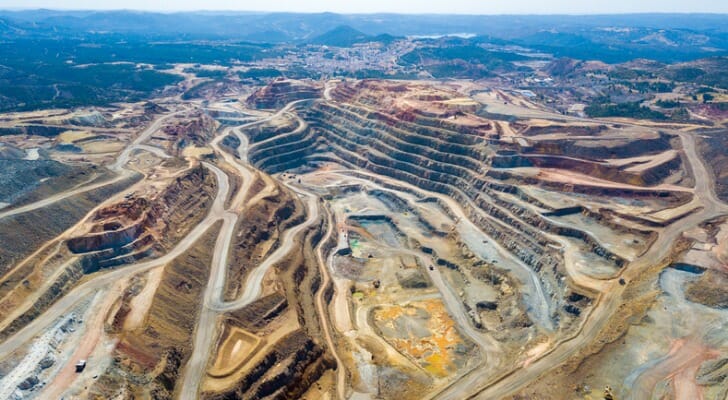Copper has resurged in demand, particularly in the industrial sector, rising roughly five times in value from 2001 to 2022. It is a versatile metal used heavily in home building, electronics, electrical conductivity, automobiles and infection control. It will benefit from the push toward electric vehicles and sustainable energy sources, upgraded infection control due to the coronavirus pandemic and rebounding global economic activity.
A financial advisor can help you add copper and other precious metals to your portfolio.
Among the commodities known as industrial or base metals, only iron ore and aluminum are more in demand than copper. Homes have copper in the air conditioning units, water pipes and appliances. Electric cars will have more copper in them than gasoline-powered vehicles. Charging stations for electric cars and many future infrastructure improvements will need copper. Any uptick in economic activity usually fuels home building and sales from which copper will benefit. Hospitals are changing many surfaces that you can touch to copper since viruses and bacteria cannot live on the metal. All of this leads to a potential increase in copper demand and even more interest from investors.
The Copper Market
Copper is both versatile and plentiful. We have mined only a fraction of the world’s supply of copper. One of the reasons is that copper is recyclable. Once it is in circulation, it has numerous uses for which it can be recycled. There are mining issues with copper. Copper deposits are often only 0.05% to 1% copper ore. To extract that tiny fraction of marketable ore entails a process that is highly capital intensive.
In addition, copper has some supply issues that are a potential problem. Many mines were shut down during the coronavirus pandemic, which hit the supply of copper hard. There are also labor issues that have been a factor and could be in the future. The various supply issues increase copper’s price volatility.
Chile is the world’s largest producer of copper, followed distantly by Peru. Not only is Chile No. 1 due to copper mining, but it has the most copper reserves. Developing countries, especially China and India, are big users of copper due to their infrastructure needs and China is the world’s largest importer of copper. As the U.S. moves toward improving its infrastructure, copper will be in even more demand. Copper is also heavily traded in the commodities and futures markets, which could mean price volatility. However, copper can be used as a hedge against inflation.
Key Metrics in the Copper Market
If you are going to invest in copper mining securities, it’s important to look for high leverage ratios. If the ratios of debt to assets or debt to equity are out of bounds as compared to the rest of the industry, that is a warning sign. When copper prices are low, firms can accumulate a lot of debt since the necessary capital investment is so high and the company may not have enough cash flow.
Because copper is a capital intensive industry, they have a lot of depreciation and amortization on their financial statements. Depletion is also a factor. These items lower net income. It is wise to look at a company’s income statement and analyze the EBITDA instead of just relying on net income. EBITDA is earnings before interest, taxes, depreciation and amortization.
Comparing cash flow among the companies in each sector of the copper mining industry will also yield information on net income and non-cash charges like depreciation. Analyzing a company’s debt in relation to the EBITDA is important since it measures debt as compared to earnings before removing the big costs of depreciation and amortization.
If a copper company is trying to expand through acquisition, take a hard look at the acquisitions before you invest. Copper companies traditionally don’t have good luck with acquisitions when they expand outside their industry.
Different sectors of the copper industry may have different standards for each of these metrics so it is important to make comparisons with specific parts of the copper industry.
Four Ways to Invest in Copper
There are many ways to invest in copper, some direct and some indirect. Here are four common investments:
- Bullion. You can invest in copper bullion by buying bars, coins or rounds. Although storage can be a problem when investing directly in physical copper, the U.S. Mint makes copper bars in a one-ounce size. Of course, you need 16 of them to make a pound, which since 2010 has traded between $2 and $5. If you make a large investment, you may have a storage problem.
- Stocks. Most of the stock investment in copper is in copper mining companies. Before you invest in copper stocks, run the key metrics to determine the viability of the companies in the industry. Look at their history and plans. Then, go a step further and determine the global economic outlook for copper as well as environmental and corporate governance issues. There are only a few companies listed on an exchange that have copper as part of their business.
- Options. Copper investing can be done by purchasing options on the future’s contracts. If the owner of an option decides they don’t want to fulfill their contract, they can walk away and only lose the money they have already paid to purchase the contract. Options have a strike price and if the value of the option rises above that, options owners can exercise their option since they will be in the money.
- Futures. There are only a few exchanges where copper futures are traded. Two are COMEX and the London Metal Exchange. Both are exchanges for trading metals. Futures can be used to hedge against risk in the copper industry, but you have to consider the substantial risk in the futures market when investing.
Risks and Benefits of Copper Investing
Investing in copper has inherent risks due to the nature of the copper mining operation. It is expensive due to the capital requirements. It requires companies to take on a lot of debt, which could lead to bankruptcy. Copper mining is environmentally and socially controversial. A copper mine covers a large geographic area. This leads to corporate governance concerns.
There are labor disputes in Chile with the copper miners. If the price of copper drops, there is likely to be a slowdown in supply because companies can’t afford to mine. Uncertain global economic activity will also slow down copper supply since so much copper is used in home building and in automobiles. Unpredictable events like the pandemic can cause mine closings and supply to run short.
Copper is a frequently traded commodity. But, there are only a few traditional investment vehicles for copper because of the limited number of companies in the business. Investing in the available ETF or exchange-traded note is a less risky possibility. Even then, familiarity with the copper market is necessary.
Despite the risks of investing in copper, there are benefits. Global demand is supposed to skyrocket due to the global recovery and the myriad of uses of copper both in the housing and building industries and many consumer industries. Increasing amounts of copper will be needed as we use more renewable energy and move toward electric vehicles. China, as it further develops, will continue to be an important importer of copper.
Copper can provide the individual investor with diversification in their portfolio. Although scarce, it is lower in price than gold and silver. It provides you a way to enter the semi-precious metals market with a more economical investment. However, copper is not like gold, which is a counter-cyclical metal. Copper, on the other hand, is cyclical; it moves with the broader market.
Bottom Line
The price of copper is a leading indicator of economic growth. The recovery of the global economy will be evident in the price of copper, which is set by the free market. Investors looking to diversify their portfolios through commodities and futures investing have an opportunity due to the increased demand for copper. Barring unforeseen events, the demand for copper will likely continue to grow due to its versatility. Since it is a commodity, it has the price volatility associated with the commodities market. Copper can serve as a hedge against inflation, something that has been growing in 2021. If you want to invest in copper, there are a number of options ranging from the physical copper to the futures and options market.
Tips for Investing
- Due to the risk associated with trading commodities like copper, consider working with a financial advisor. SmartAsset’s free tool matches you with up to three financial advisors who serve your area, and you can interview your advisor matches at no cost to decide which one is right for you. If you’re ready to find an advisor who can help you achieve your financial goals, get started now.
- Use the free SmartAsset asset allocation calculator to see how an investment in copper could affect your portfolio.
Photo credit: ©iStock.com/SimoneN, ©iStock.com/Luis Becerra berbel, ©iStock.com/Thomas Demarczyk


